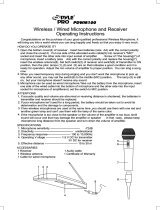
5
SW915 DIGITAL AUDIO TRAVEL PARTNER
inputS and outputS:
MICROPHONE/INSTRUMENT INPUTS:
There are 3 types of input jacks on your DIGITAL AUDIO TRAVEL
PARTNER, as follows:
2 – 1/8” phone jacks (3.5 mm)
2 – RCA jacks
3 – XLR or ¼” combination jacks (this jack will accept either type)
There are two types of microphones the DIGITAL AUDIO TRAVEL PARTNER
is designed for Dynamic - for standard dynamic cartridge microphones
Condenser - for electret or condenser microphones, which require
phantom power (supplied from the amplifier)
There are three microphone channels (Channel 1, Channel 2, and Channel
3), and each channel has individual volume controls. Each channel will
accept any of the listed microphone types, but only one microphone or
instrument should be plugged into each channel at a time.
Add pre-recorded music to your presentations with the internal CD or
tape player. Channel 3 Volume Control adjusts the volume for these
units. In addition, an external source such as a computer or MP3 player
can be used by connecting to jack(s) on any available channel.
RECORD/LINE OUT:
This jack provides the output of the mixer. To record or connect to a
house PA system, external equalizer, audio mixer, or transmitter of
AmpliVox S1297-70 wireless powered companion speaker, connect
the LINE OUT on the amplifier, to the input on an external recorder or
PA system. This jack functions the same as a signal “send”.
(See Special Features Section)
USB INTERFACE
When a computer is connected through the USB interface, the audio
portion of any multimedia programs (such as PowerPoint, Windows
Media Player, etc.) used on the computer will be heard on the 915. The
volume and tone controls in the computer program will determine the
loudness and sound characteristics of what’s heard from the computer
program through the 915.
LINE INSERT
Use this jack to supply a signal directly to the power amp. This jack
functions as a signal “return”. Doing so will disconnect the mixer
section of the DIGITAL AUDIO TRAVEL PARTNER and instead will apply
the signal supplied to this jack directly to the power amp and speakers
of the SW915. This input along with the record/line out can be used
to electronically insert an external device such as a graphic equalizer
between the mixer and the power amp to provide additional signal
processing. (See Special Features Section)
Mixer stage – includes all the individual volume controls, input jacks
(14”-XLR combo, 3.5mm, RCA) and mic/line & phantom power switches
for the 5 input channels (2 internal wireless, 3 direct or corded) ‘Record/
Line Out’ and ‘Line Insert’ stage – see below.
Output stage - includes the music/voice switch, treble, bass & master
volume controls, power amps and speakers.
SPECIAL FEATURES
The DIGITAL AUDIO TRAVEL PARTNER panel has ¼” phone jacks
labeled ‘Record/Line Out’ and ‘Line Insert’ respectively. ‘Record/Line
Out’ provides a feed from the Mixer stage, but before this signal goes
through the Output stage. In other words, this signal is not affected
by settings on the music/voice switch, treble, bass & master volume
controls. It can be used to drive an external recording device or another
audio system. The advantage to this configuration (pre-EQ & master
volume) is that the external system’s own EQ & volume settings can be
separately adjusted to suit its environment and the two systems do not
interact with each other.
The ‘Line Insert’ jack works in two ways. When no plug is inserted it
internally connects the Mixer to the Output. However, when a plug is
inserted it disconnects the Mixer from the Output, replacing it with
the external audio signal from the device the plug’s cable is attached
to. In this configuration, the DIGITAL AUDIO TRAVEL PARTNER Output
stage can be used to amplify a feed from an external mixer or playback
device. For instance, assume a facility’s main meeting room has a built-
in sound system, but the adjoining room for the overflow crowd has no
system. A ‘Line Out’ feed from the house system could be plugged into
the ‘Line Insert’ jack of a DIGITAL AUDIO TRAVEL PARTNER located in
the overflow room. The DIGITAL AUDIO TRAVEL PARTNER’s EQ & master
volume can then be adjusted to suit the overflow room’s conditions
without any effect on the main system.
The other way this pair of jacks can be used is to insert an external
device such as a graphic equalizer, echo/reverb machine or other audio
processing device between the Mixer and Output stages of the DIGITAL
AUDIO TRAVEL PARTNER. The ‘Record/Line Out’ on the ‘915 connects
to the ‘Line In’ of the external device and its ‘Line Out’ connects to the
‘915 ‘Line Insert’. Remember from the above discussion that a plug
in the ‘Line Insert jack breaks the direct internal connection from the
Mixer so in effect the external device is electrically inserted between the
2 stages and becomes a functional block of the DIGITAL AUDIO TRAVEL
PARTNER.
FUSES
There are two circuit protection devices that are user serviceable. The
25A circuit breaker protects the power supply and battery circuits.
Press to reset.
There is also a fuse in the AC jack. It is identified on the plastic with a
drawing of a fuse. ***DETACH THE AC CORD FROM THE UNIT BEFORE
FUSE REPLACEMENT*** This fuse protects the AC circuitry. Use a flat
blade screwdriver in the slot on the top of fuse holder to slide the fuse
holder out. Replace the fuse with a 10A/250V fuse if needed. If after
resetting and replacing the breaker and fuse , the SW915 Digital Audio
Travel Partner does not “power on”, please call AmpliVox Customer
Service at 800-267-5486.
WARNING! RISK OF SHOCK! DO NOT OPEN UNIT NO USER SER-
VICEABLE PARTS INSIDE!















